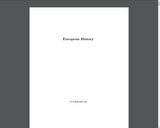
A basic outline of Western Civilization from the Renaissance to modern times.

A basic outline of Western Civilization from the Renaissance to modern times.
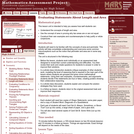
This lesson unit is intended to help teachers assess how well students can: Understand the concepts of length and area; use the concept of area in proving why two areas are or are not equal; and construct their own examples and counterexamples to help justify or refute conjectures.
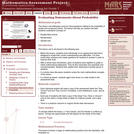
This lesson unit addresses common misconceptions relating to probability of simple and compound events. The lesson will help you assess how well students understand concepts of: Equally likely events; randomness; and sample sizes.
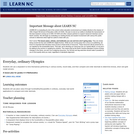
Students will use a stopwatch to time themselves performing in various events, record data, and then compare and order decimals to determine bronze, silver and gold medal winners.
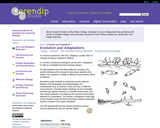
In common experience, the term "adapting" usually refers to changes during an organism's lifetime. In contrast, evolutionary biologists use the term "adaptation" to refer to a heritable trait that increases fitness. To help students reconcile these different concepts, this activity introduces the concept of phenotypic plasticity (the ability of an organism to adapt to different environments within its lifetime). Questions guide students in analyzing how the balance between the advantages and disadvantages of a characteristic (e.g. an animal's color) can vary in different circumstances, how phenotypic plasticity can be a heritable trait that can optimize fitness in a variable environment, and how natural selection can influence the amount of phenotypic plasticity in a population. This activity is designed to help high school students meet the Next Generation Science Standards and the Common Core State Standards.
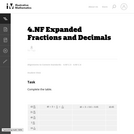
The purpose of this task is for students to show they understand the connection between fraction and decimal notation by writing the same numbers both ways.
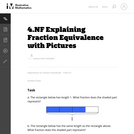
The purpose of this task is to provide students with an opportunity to explain fraction equivalence through visual models in a particular example.
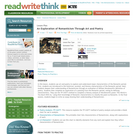
Students use art and poetry to explore and understand major characteristics of the Romantic period.
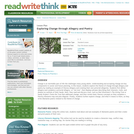
Students read an example of allegory, review literary concepts, complete literary elements maps and plot diagrams, create a pictorial allegory, and write diamante poems related to the theme of change.

Students create movements to represent long and short rhythmic patterns and compose patterns using non-traditional notation.

Students will explore the concepts of place value, moving their bodies in a variety of ways to represent the tens and ones places. They will express place value with unifix cubes and drawings as they compose and decompose two-digit numbers
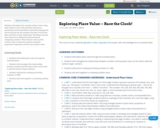
Students will explore the concepts of place value using their bodies as tools. They will time themselves performing various kinesthetic tasks like jumping jacks and sit ups and use the numbers that they record from these activities in their exploration. Working in groups, they will practice adding and subtracting and comparing numbers. They will also come up with creative ways to represent numbers using the properties of operation and the rules of place value.
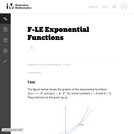
In this task students prove that linear functions grow by equal differences over equal intervals, and that exponential functions grow by equal factors over equal intervals.

This problem illustrates how an exponentially increasing quantity eventually surpasses a linearly increasing quantity.

According to the GED testing service, test takers struggle with “applying rules of exponents in numerical expressions with rational exponents to write equivalent expressions with rational exponents.” (https://www.gedtestingservice.com/uploads/files/09738c12fe4e4accd9a16bab7cb99a3c.pdf )
Students do “fairly well” with simple squares and square roots, but there is a “sharp drop-off” when things get more complicated.
These are questions included in the “no calculator” portion of the test.
These skills are Mathematics Standards Level D in the College and Career Readiness Standards for Adult Education (https://www.educateiowa.gov/sites/files/ed/documents/CCRStandardsAdultEd.pdf ) under “Expressions and Equations.”
This curriculum guide will offer opportunities to build the deeper understanding necessary to understand the rules of exponents such as (xm)n = xmn .
Write and evaluate numerical expressions involving whole-number exponents. (6.EE.1)
Know and apply the properties of integer exponents to generate equivalent numerical expressions. (8.EE.1)
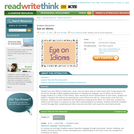
The activity includes a series of exercises, in which students view the literal representations of idioms and then examine the metaphorical meanings of the idioms.
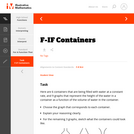
This is a task from the Illustrative Mathematics website that is one part of a complete illustration of the standard to which it is aligned. Each task has at least one solution and some commentary that addresses important aspects of the task and its potential use.
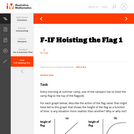
This is a task from the Illustrative Mathematics website that is one part of a complete illustration of the standard to which it is aligned. Each task has at least one solution and some commentary that addresses important aspects of the task and its potential use.

This is a task from the Illustrative Mathematics website that is one part of a complete illustration of the standard to which it is aligned. Each task has at least one solution and some commentary that addresses important aspects of the task and its potential use.

K-1st lesson designed to develop class routines and procedures while providing students the opportunity to develop locomotor skills as well as build social emotional skills.